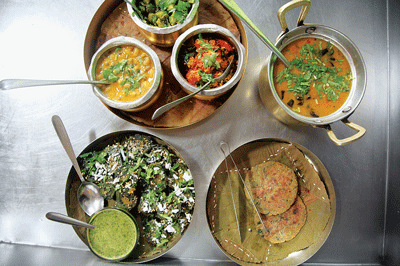
Gujarat: Land in Between
Gujarat’s geographical position places Gujarati cuisine at a crossroads.
Gujarat's geographical position—on India's west coast, roughly halfway between the subcontinent's northern and southern tiers—places Gujarati cuisine at a crossroads. For eaters accustomed to the creamy, onion-infused curries of the northern Indian states of Punjab, Haryana, and Kashmir—comparatively lavish dishes, with clear roots in Mughal court cooking—the foods of Gujarat seem strikingly different at first glance. For one thing, quick cooking methods like stir-frying and steaming are dominant in Gujarat, yielding dishes with cleanly defined flavors and vibrant colors, as opposed to the slow-braised dishes typical of Mughal cooking. For another, warming spices like cloves and cardamom, so central to the flavor palate of Northern Indian cooking, are used sparingly by most Gujarati cooks. And yet, Gujarati cooking does bear a notable similarity to Punjabi cuisine: both food cultures rely heavily on flours made from pulses and cereal grains—in the north, for making breads, and in Gujarat for breads, in sweets, and as a thickener in curries.
For those acquainted with the cuisines of India's deep south—a region comprising the states of Karnataka, Kerala, and Tamil Nadu—Gujarati cooking may seem more familiar. Like Gujarati cuisine, the cooking of South India doesn't include the kinds of thick-sauced, long-cooked dishes native to the north. Additionally, the cuisines of both South India and Gujarat have dishes flavored with similar spices, black mustard seeds and cumin foremost among them. The way cooks in the two regions use those spices is similar, too—most often quick-frying them whole before adding other ingredients to the pan. But a more than casual observation of Gujarati dishes reveals a profound departure from the cooking of the south. The Gujarati predilection for sweetening savory dishes with jaggery is mostly unknown in the south, as is the free-wheeling use of ghee (clarified butter), which lends Gujarati dishes a richness that, if anything, is more akin to that of the northern states. And, perhaps most significantly, rice on the Gujarati table, if seen at all, is typically a side dish, whereas in the south it is the very foundation of a meal.
Keep Reading
Continue to Next Story










